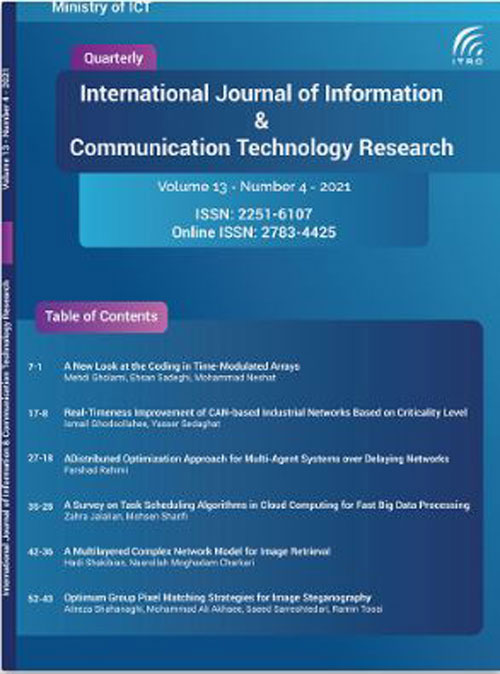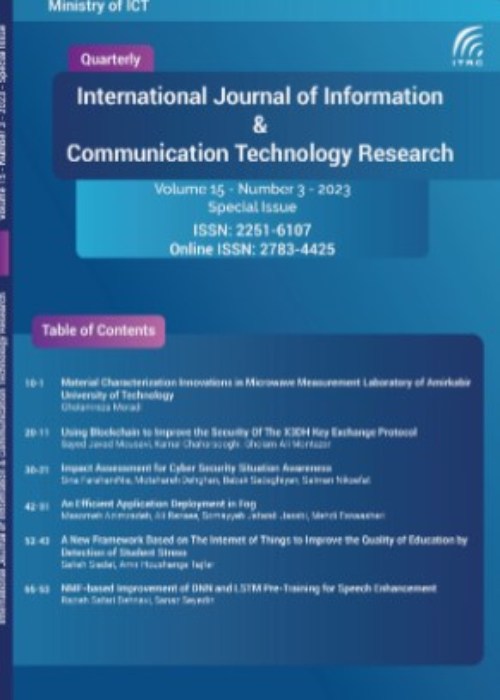فهرست مطالب

International Journal Information and Communication Technology Research
Volume:14 Issue: 1, Winter 2022
- تاریخ انتشار: 1401/03/22
- تعداد عناوین: 6
-
-
Pages 1-12
The most important challenge in wireless sensor networks is to extend the network lifetime, which is directly related to the energy consumption. Clustering is one of the well-known energy-saving solutions in WSNs. To put this in perspective, the most studies repeated cluster head selection methods for clustering in each round, which increases the number of sent and received messages. what's more, inappropriate cluster head selection and unbalanced clusters have increased energy dissipation. To create balanced clusters and reduce energy consumption, we used a centralized network and relay nodes, respectively. Besides, we applied a metaheuristic algorithm to select the optimal cluster heads because classical methods are easily trapped in local minimum. In this paper, the Grey Wolf Optimizer(GWO), which is a simple and flexible algorithm that is capable of balancing the two phases of exploration and exploitation is used. To prolong the network lifetime and reduce energy consumption in cluster head nodes, we proposed a centralized multiple clustering based on GWO that uses both energy and distance in cluster head selection. This research is compared with classical and metaheuristic algorithms in three scenarios based on the criteria of "Network Lifetime", "Number of dead nodes in each round" and "Total Remaining Energy(TRE) in the cluster head and relay nodes. The simulation results show that our research performs better than other methods. In addition, to analyze the scalability, it has been evaluated in terms of "number of nodes", "network dimensions" and "BS location". Regarding to the results, by rising 2 and 5 times of these conditions, the network performance is increased by 1.5 and 2 times, respectively.
Keywords: Multi-clustering, Centralized, Energy efficient, Grey wolf algorithm, Wireless sensor network -
Pages 13-24
In this paper, we study the spectral efficiency (SE) and energy efficiency (EE) of wireless-powered full-duplex (FD) heterogeneous networks (HetNets). In particular, we consider a two-tire HetNet with half duplex (HD) massive multiple-input multiple-output (MIMO) macrocell base stations (MBSs), FD small cell base stations (SBSs) and FD user equipments (UEs). UEs rely on energy harvesting (EH) from radio frequency signals to charge their batteries for communication with serving base stations. During the energy harvesting phase, UEs are associated to MBSs/SBSs based on the mean maximum received power (MMP) scheme. In the consecutive data transmission phase, each UE downloads packets from the same MBSs/SBSs, while uploads packets to the nearest SBSs using the harvested energy. We use tools from stochastic geometry to develop an analytical framework for the average UL power transfer and the UL and DL coverage probability analysis. We further investigate the EE of the proposed DUDe scheme to demonstrate the impact of different system parameters on the EE. Finally, we validate the analytical results through simulation and discuss the significance of the proposed DUDe user association to improve the average DL and UL SE in the wireless-powered FD HetNets.
Keywords: component, Heterogeneous networks, decoupled user association, full-duplex communications, energy harvesting, energy efficiency -
Pages 25-37
The IoT can lead to fundamental developments in health, education, urbanization, agriculture, industry, and other areas. Regarding the variety of different end-user applications and needs, developing a versatile communication network that can support such diverse and heterogeneous applications is necessary to decrease the implementation costs than developing a dedicated communication network for each application. LoRa is a type of LPWAN networks that is supported by LoRa Alliance and due to long-range communication and low power and reasonable cost, IoT has become the main goal of establishing LoRa. LoRaWAN covers the protocol and architecture of the system on top of the LoRa physical layer. The LoRa physical layer uses proprietary CSS modulation. This modulation operates below the noise level and is resistant to fading, interference, and blocking attacks, and is difficult to decode. LoRa operates in the unlicensed frequency band below 1GHz with different frequencies in different geographical areas. LoRa is much more useful for IoT applications than short-range protocols such as WiFi and Bluetooth, despite limitations in data transfer speeds and QoS. Therefore, in this manuscript, considering the importance and advantages of LoRa, this protocol is introduced and its various network aspect, importance, and application are examined. Then, a solution based on the cognitive radio technique is presented for QoS improvement to utilize the LoRa technology as a kind of versatile communication infrastructure for IoT.
Keywords: component, Heterogeneous networks, decoupled user association, full-duplex communications, energy harvesting, energy efficiency -
Pages 38-47
People's influence on their friends' personal opinions and decisions is an essential feature of social networks. Due to this, many businesses use social media to convince a small number of users in order to increase awareness and ultimately maximize sales to the maximum number of users. This issue is typically expressed as the influence maximization problem. This paper will identify the most influential nodes in the social network during two phases. In the first phase, we offer a community detection approach based on the Node2Vec method to detect the potential communities. In the second phase, larger communities are chosen as candidate communities, and then the heuristicbased measurement approach is utilized to identify influential nodes within candidate communities. Evaluations of the proposed method on three real datasets demonstrate the superiority of this method over other compared methods.
Keywords: social network mining, influence analysis, influence maximization problem, influential nodes -
Pages 48-55
Recommender systems are one of the extensively used knowledge discovery applications in database techniques and they have gained a lot of attention in recent years. These systems have been applied in many internet-based communities and businesses to make personalized recommendations and eventually in order to obtain higher profits. The core entity in recommender systems is ratings from users to items. However, there are many auxiliary pieces of information that can be used to get better performance. The personality of users is one of the most useful information that helps the system to produce more accurate and suitable recommendations. It has been proved that the characteristic of a person can directly affect his or her behavior. Therefore, in this paper the personality of users is extracted and a mathematical and algorithmic approach to utilize this information is proposed. The base model that is used is matrix factorization, which is one of the most powerful methods in recommender systems. Experimental results on MovieLens dataset demonstrate the positive impact of personality information on the matrix factorization technique and also reveals better performance by comparing with the state-of-the-art algorithms
Keywords: recommender system, matrix factorization, knowledge discovery, personality -
Pages 57-68
Cancer-causing genes are genes in which mutations cause the onset and spread of cancer. These genes are called driver genes or cancer-causal genes. Several computational methods have been proposed so far to find them. Most of these methods are based on the genome sequencing of cancer tissues. They look for key mutations in genome data to predict cancer genes. This study proposes a new approach called centrality maximization intersection, cMaxDriver, as a network-based tool for predicting cancer-causing genes in the human transcriptional regulatory network. In this approach, we used degree, closeness, and betweenness centralities, without using genome data. We first constructed three cancer transcriptional regulatory networks using gene expression data and regulatory interactions as benchmarks. We then calculated the three mentioned centralities for the genes in the network and considered the nodes with the highest values in each of the centralities as important genes in the network. Finally, we identified the nodes with the highest value between at least two centralities as cancer causal genes. We compared the results with eighteen previous computational and network-based methods. The results show that the proposed approach has improved the efficiency and F-measure, significantly. In addition, the cMaxDriver approach has identified unique cancer driver genes, which other methods cannot identify.
Keywords: Cancer-causing genes, Transcriptional regulatory network, Maximization, Centrality, Intersection


